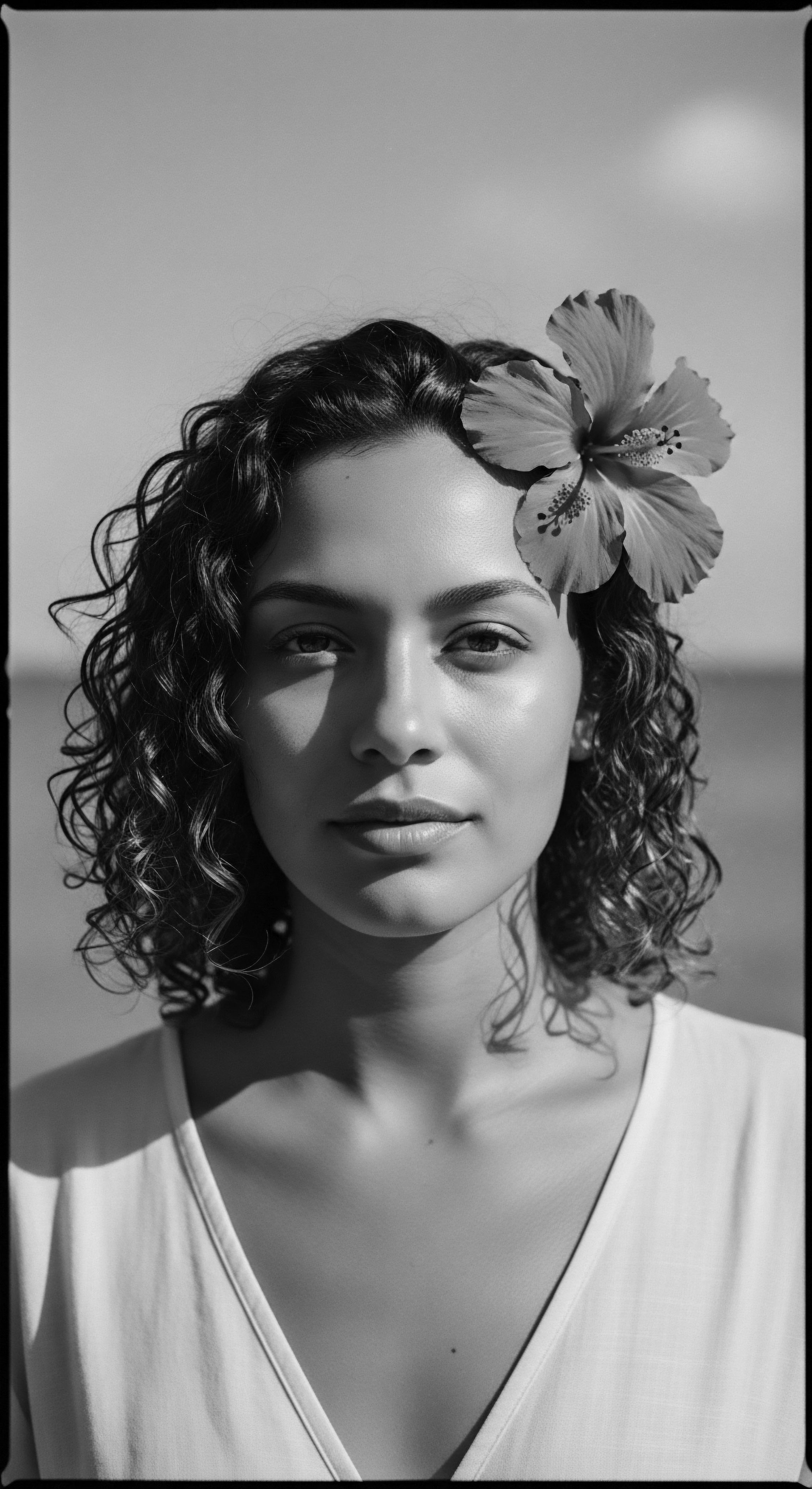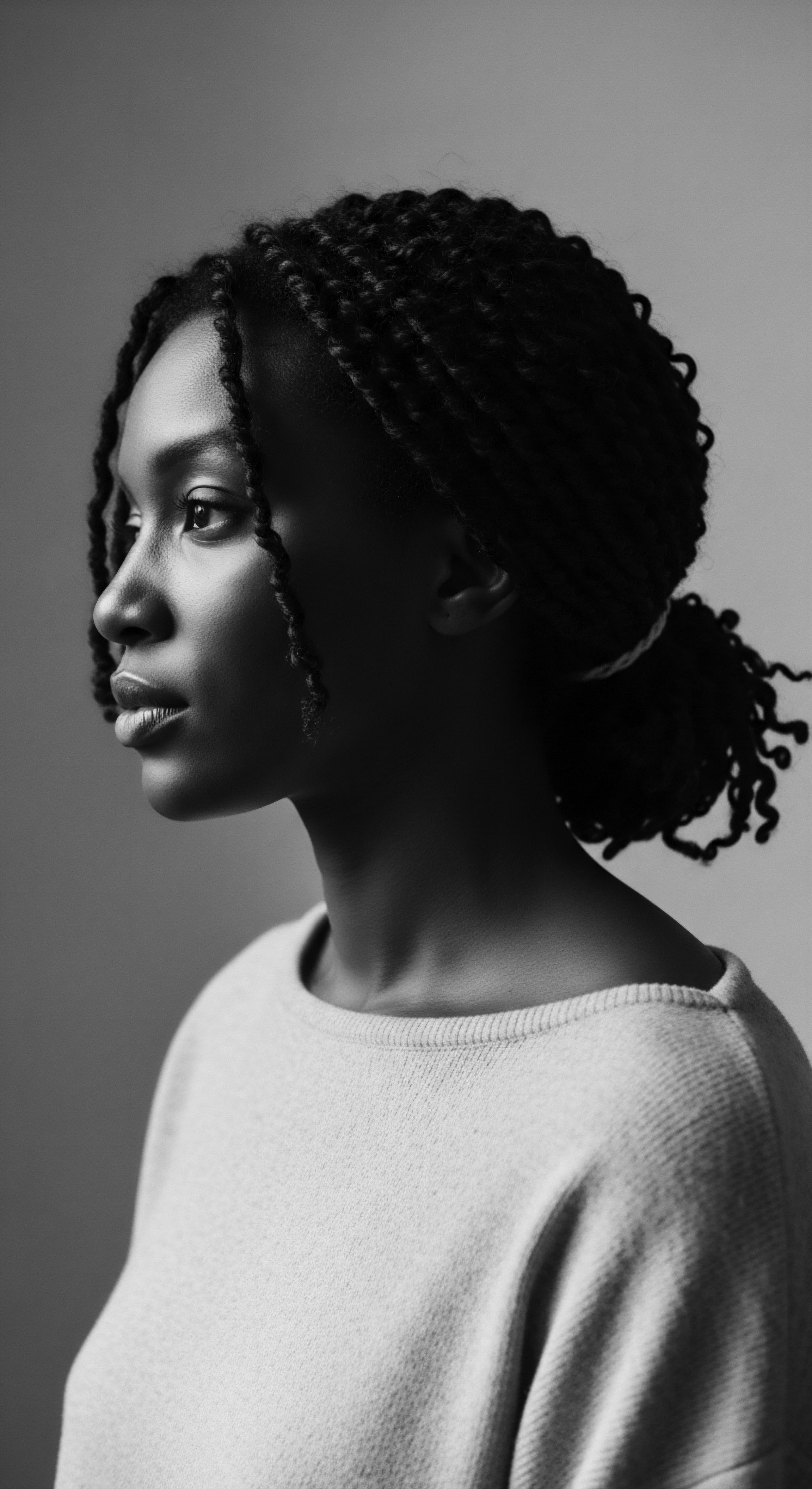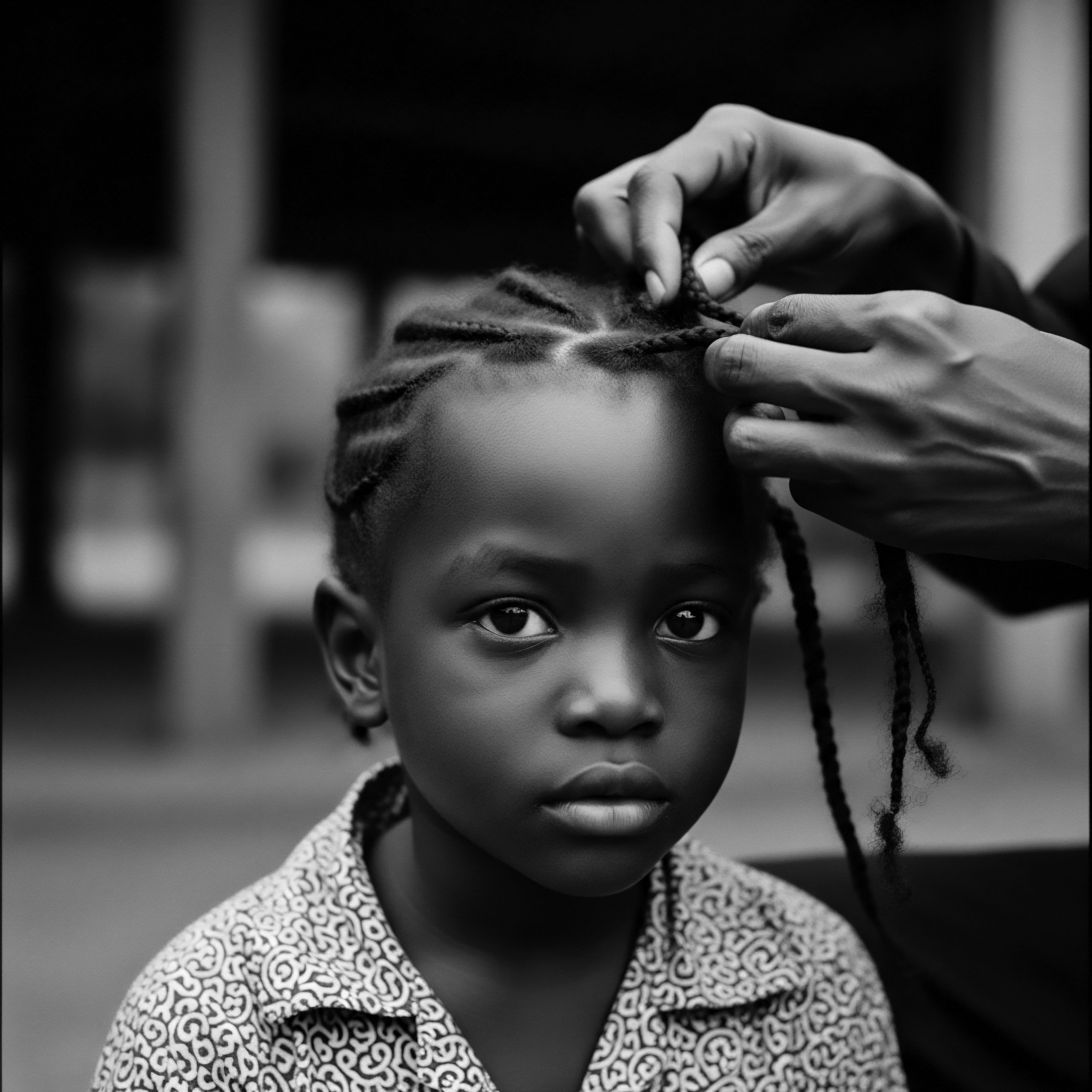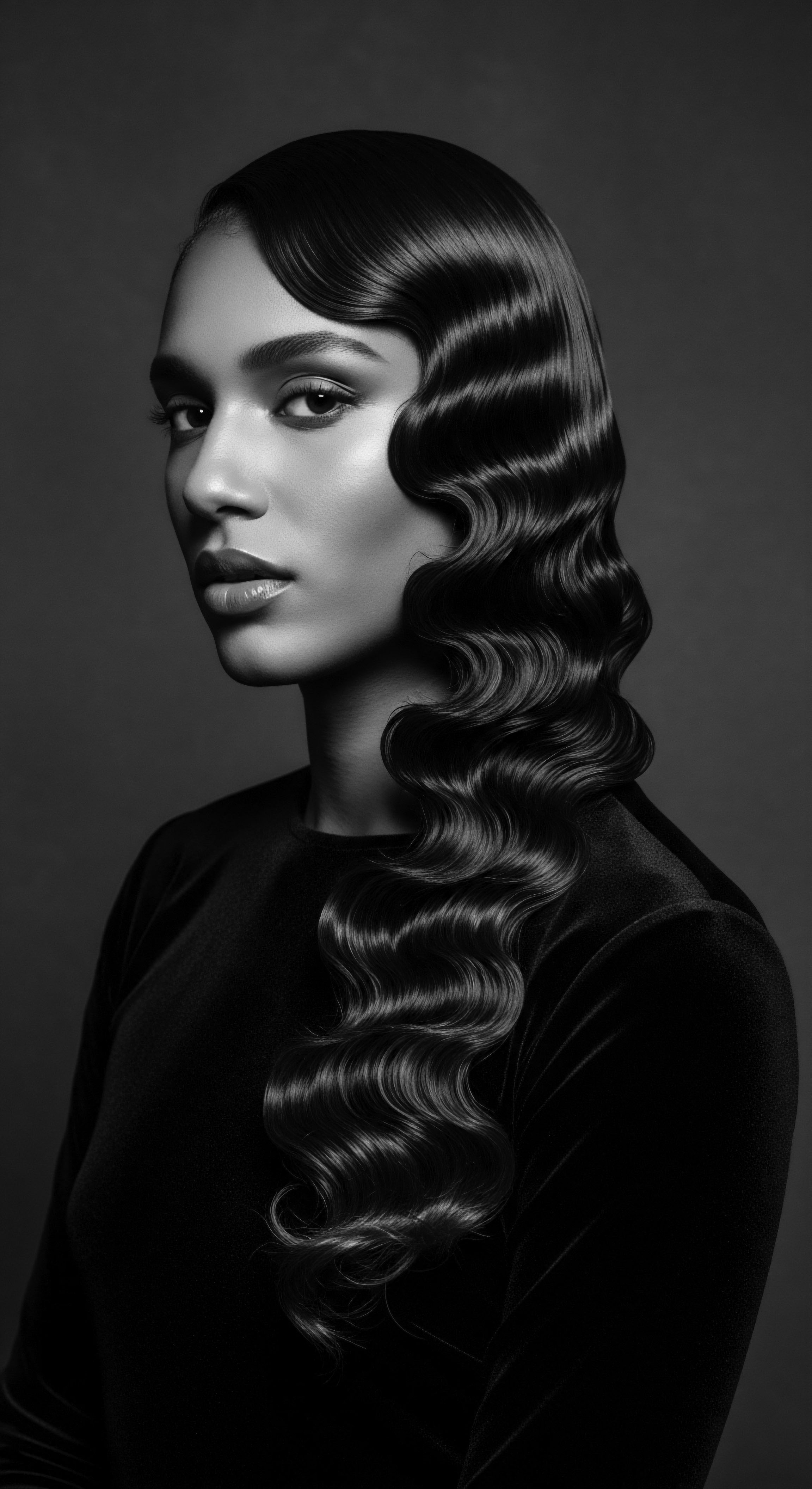
Roots
The very strands that crown our heads, particularly those with the intricate coils and waves of textured hair, are more than mere adornment. They serve as living archives, holding within their delicate structure the echoes of ancestral wisdom, resilience, and identity. For generations, hair has been a language, a statement, and a connection to the deepest parts of self and community across Black and mixed-race lineages.
It is within this sacred understanding that we approach the question of whether traditional ingredients, specifically the revered shea butter, can scientifically safeguard textured hair. This is a journey through time, a meditation on how ancient practices, passed down through the gentle hands of mothers and elders, converge with modern scientific understanding to affirm a heritage of profound care.

The Architecture of Textured Hair
To truly grasp the protective prowess of ingredients like shea butter, one must first appreciate the singular architecture of textured hair. Unlike straight hair, the elliptical or flattened cross-section of a coily strand causes its cuticle scales to lay less flat. This inherent characteristic, a gift of genetic inheritance, can render textured hair more susceptible to moisture loss and external aggressors. The hair shaft itself is a complex proteinaceous filament, primarily composed of Keratin, a robust fibrous protein.
Surrounding this core, the cuticle acts as the outermost shield, a layer of overlapping scales, much like shingles on a roof. These scales, when healthy, lie smoothly, reflecting light and locking in vital hydration. Yet, the very spirals of textured hair mean these cuticles are naturally more lifted, creating pathways for moisture to escape and environmental factors to intrude.
Beyond the keratin, lipids play a silent yet powerful role in hair’s integrity. These fatty, waxy compounds, which form about 2-6% of hair’s weight, reside both on the surface and within the hair shaft, acting as a natural barrier against environmental damage and moisture escape. Without sufficient lipids, hair can become brittle, prone to breakage, and dull.
The lipid layer on the hair’s surface creates a protective coating. When this layer is compromised, the hair becomes more water-loving, making it susceptible to swelling and subsequent damage from water and styling products.

A Heritage of Golden Care
The story of shea butter begins in the Sudano-Sahelian region of West and East Africa, where the Vitellaria Paradoxa tree flourishes, often referred to as the “tree of life”. Its fruit yields a precious nut, from which the ivory-to-yellow butter is extracted through processes honed over millennia. Archaeological sites confirm shea butter production as far back as 100-1700 CE. It has been a constant presence in African life, not only for personal care but also for culinary, therapeutic, and even spiritual purposes.
The earliest recorded instances of its widespread use stretch back to the reign of Queen Cleopatra (51-30 B.C.), who is said to have stored shea oil in large clay jars, transporting it via caravans for her skin and hair rituals. This is not merely a beauty secret of antiquity; it speaks to a deep, generational understanding of the butter’s nourishing properties.
The production and trade of shea butter have been intimately tied to women across Africa for centuries. It earned the name “women’s Gold”, a recognition of its economic significance and the fact that its supply chain is largely controlled by millions of African women. This ancestral practice, passed from mother to daughter, represents a powerful legacy of female entrepreneurship and community sustenance.
Shea butter, a golden offering from West Africa’s ‘tree of life,’ has held a sacred place in hair care for millennia, a testament to inherited wisdom.

How Does Textured Hair Structure Benefit From Traditional Lipid Content?
Textured hair, with its unique coil pattern, inherently presents a greater challenge in retaining moisture. The curves and bends along the hair shaft create more opportunities for the cuticle layer to lift, allowing water to escape. Traditional ingredients rich in lipids, like shea butter, act as a formidable ally against this inherent vulnerability. The rich fatty acid profile of shea butter, including Oleic Acid, Stearic Acid, and Linoleic Acid, forms a protective film around the hair shaft, sealing in moisture and smoothing down those lifted cuticles.
This external coating reduces water loss, which is a common concern for textured hair that often feels dry. The concept of “sealing” moisture, a cornerstone of modern textured hair care, finds its roots in these ancient practices, where nourishing oils and butters were applied to hair to maintain its softness and malleability in harsh climates.
Beyond surface protection, the lipids in shea butter also contribute to the overall structural integrity of the hair. While keratin provides strength, lipids are akin to the mortar that binds the bricks of keratin together, lending elasticity and flexibility. This helps to minimize breakage and split ends, particularly for hair that is prone to mechanical stress from styling or environmental exposure.

Ancestral Understanding of Hair’s Vitality
Across diverse African cultures, hair was not simply a physical attribute; it held profound spiritual, social, and communicative meanings. Hairstyles indicated status, age, marital status, ethnic identity, wealth, and even spiritual messages. The elaborate care rituals, which sometimes spanned hours or days, involved washing, combing, oiling, braiding, and decorating the hair.
These were not just chores; they were communal activities, opportunities for bonding and the transmission of wisdom. The application of natural butters and oils was an intrinsic part of these ceremonies, understood instinctively to preserve the hair’s health and beauty, ensuring it remained a vibrant symbol of one’s identity and connection to heritage.

Ritual
The ancient rhythms of hair care rituals were not haphazard acts; they were precise, intentional practices woven into the fabric of daily life and ceremonial moments. For generations, the hands that touched textured hair understood its distinct needs, drawing upon the earth’s bounties to create balms and concoctions that guarded each coil and strand. This deep connection between traditional care and modern scientific understanding is particularly apparent when observing how ingredients like shea butter historically intertwined with protective styling, shaping both the hair itself and the identity it expressed.

The Art of Hair Preservation
Protective styling, a practice celebrated today for its role in hair length retention and damage prevention, finds its genesis in ancestral African traditions. Braids, twists, and various forms of threading were not merely aesthetic choices; they served vital functional purposes, shielding delicate hair from environmental elements like harsh sun, dust, and wind, while also communicating social and spiritual narratives. The Himba tribe of Namibia, for instance, famously coats their hair in a mixture of red ochre and butter, a practice that not only carries deep cultural meaning but also offers physical protection against the arid climate. This historical practice highlights an inherent understanding of hair’s vulnerability and the intuitive wisdom of using natural resources for its preservation.
The application of shea butter became a cornerstone within these traditional styling practices. Its emollient properties made hair more pliable, facilitating the intricate braiding and twisting techniques that often secured hair for extended periods. Beyond its functional role, the act of applying shea butter, often shared between women, reinforced community bonds and served as a tangible expression of care passed through generations.
| Ancestral Practice Application of natural butters and oils to hair and scalp for suppleness. |
| Contemporary Scientific Insight Shea butter's rich fatty acids (oleic, stearic) create an occlusive barrier, reducing transepidermal water loss from the scalp and sealing moisture into the hair shaft. |
| Ancestral Practice Intricate braiding and threading for extended wear. |
| Contemporary Scientific Insight Protective styling minimizes mechanical manipulation, reducing breakage and enabling length retention. |
| Ancestral Practice Use of scarves and head coverings. |
| Contemporary Scientific Insight Fabrics like silk or satin reduce friction, preventing cuticle damage and moisture stripping from cotton surfaces. |
| Ancestral Practice Ancestral hair care wisdom often aligns with modern scientific understanding of hair biology and protective mechanisms. |

What Ancestral Styling Practices Demonstrate Shea’s Protective Qualities?
Across West Africa, where the shea tree is native, the butter was consistently integrated into hair preparation. For many, it was the finishing balm after cleansing, worked through strands before being intricately styled into cornrows, Bantu knots, or other complex designs. These styles, meant to be long-lasting, benefited immensely from shea butter’s ability to lock in moisture and keep the hair soft and resilient, preventing the drying and brittleness that could lead to breakage. The butter provided a natural weight, helping to define the texture and reducing frizz, thus preserving the aesthetic integrity of the style for longer durations in challenging climates.
One notable historical example is the widespread use of oils and butters for hair protection during the Transatlantic slave trade. While enslaved Africans were forcibly stripped of many cultural practices, including their traditional hair tools and methods, they found ways to maintain their identity through hair. They adapted, using whatever materials were available, including natural oils and animal fats, to moisturize and preserve their hair from the harsh conditions of plantation life. These applications were not merely cosmetic; they were acts of survival, attempts to maintain a connection to heritage and self in dehumanizing circumstances.
Shea butter, if accessible, would have been among these vital resources for its known protective qualities, keeping hair hydrated and less prone to breakage when proper care was otherwise impossible. This speaks volumes about the inherent, deeply understood protective qualities of such ingredients.
Traditional styling practices, deeply rooted in African heritage, employed shea butter to fortify hair against environmental elements, echoing scientific principles of moisture retention.

The Tools of Tradition
The holistic approach to textured hair care in ancestral communities extended to the tools employed. Beyond the hands that carefully sectioned and coiled, implements crafted from wood, bone, or even repurposed materials were used for detangling and shaping. Scarves and head coverings, often made from natural fibers, also played a dual role ❉ expressing cultural identity and shielding hair from the sun’s intensity or the night’s chill, further supporting moisture retention. Shea butter worked in concert with these practices, providing the slip needed for gentle manipulation, lubricating the hair shaft to prevent snagging during braiding, and coating strands to create a protective barrier that enhanced the benefits of protective styles.

Relay
The journey of understanding shea butter’s scientific efficacy for textured hair reaches a profound convergence where ancient wisdom meets contemporary inquiry. The meticulous observations of ancestral practitioners, honed through generations, are now illuminated by molecular biology and dermatological studies. This intergenerational transmission of knowledge forms the bedrock of our present understanding, revealing that the protective qualities long attributed to shea butter are indeed supported by its intricate biochemical composition.

Validating Ancestral Efficacy
Modern science confirms the rich array of beneficial compounds within shea butter, substantiating its historical role in hair protection. It is a natural repository of vitamins A, E, D, and F, alongside a significant content of essential fatty acids, including Oleic Acid (Omega 9), Stearic Acid, and Linoleic Acid (Omega 6). These components work in concert to address the specific vulnerabilities of textured hair.
- Oleic Acid (Omega 9) ❉ This fatty acid is a primary component of shea butter. It helps to maintain the suppleness and radiance of hair. It also contributes to stimulating the growth of stronger hair and aids in the reduction of dandruff, thereby supporting hair growth.
- Stearic Acid ❉ Imparts the solid consistency to shea butter at room temperature. It has cleansing properties and functions as an emulsifying agent. In hair, it conditions and protects without weighing strands down.
- Linoleic Acid (Omega 6) ❉ Often referred to as Vitamin F, this fatty acid is vital for moisturizing hair and promoting its growth. It also exhibits anti-inflammatory properties, which are beneficial for scalp health.
- Vitamins A and E ❉ Vitamin A aids in cell reproduction, promoting hair growth and stimulating sebum production, hair’s natural protection. Vitamin E, a known antioxidant, combats oxidative stress on the scalp, which contributes to maintaining hair health and growth.
These constituents explain shea butter’s well-documented moisturizing properties. A study observed that a cream containing 5% shea butter provided moisturizing effects for up to 8 hours after application. For textured hair, this translates directly to improved hydration, reduced dryness, and a significant decrease in split ends. The butter functions as an effective Sealant, coating the hair shaft to minimize moisture loss, a particularly valuable attribute for naturally porous textured hair.
The traditional recognition of shea butter’s soothing qualities also finds scientific grounding. Its anti-inflammatory properties, linked to the presence of Amyrin, help to calm scalp irritation and redness without clogging pores. This makes it a suitable ingredient for those experiencing common scalp conditions, contributing to a healthy environment for hair growth.

Can Modern Science Validate Shea Butter’s Historical Benefits for Textured Hair?
Yes, contemporary research significantly validates the ancestral benefits of shea butter for textured hair. The traditional practices that saw shea butter as a protective balm were, in essence, harnessing its biochemical composition to mitigate environmental damage and maintain hair health. Lipids are fundamental for maintaining hair structure, forming a protective barrier against moisture loss, and improving shine, elasticity, and tensile strength. Shea butter, being rich in these lipids, directly addresses these needs for textured hair.
It helps to smooth the cuticle scales, reducing frizz and making the hair softer and shinier. This protective barrier also shields hair from external aggressors like UV radiation and pollution, and even from the stress of heat styling. The consistent application of shea butter, as practiced ancestrally, built up this protective layer, enabling hair to withstand daily wear and tear more effectively.

Ancestral Problem Solving for Hair
Centuries before the advent of modern laboratories, ancestral communities developed sophisticated methods to address common hair concerns, relying on their deep understanding of local flora. Dryness, brittleness, and breakage were recognized as significant issues, and traditional ingredients were strategically employed. For instance, the women of the Basara tribe in T’Chad utilized a concoction of herb-infused oil and animal fat (known as Chebe) applied weekly, braided into the hair, to achieve remarkable length retention, highlighting a focus on protection rather than curl definition alone. This practice, alongside the use of whipped animal milk and water by women of Ethiopian and Somali descent, demonstrates an intuitive grasp of creating moisture-locking seals for hair.
Shea butter served a similar purpose, acting as a profound conditioner and sealant. Its consistent application, often massaged into the scalp and along the hair shaft, was believed to stimulate hair growth and alleviate scalp dryness, functions now supported by its vitamin and fatty acid content.
The cultural significance of hair meant that its health was paramount, not just for appearance, but for social standing and spiritual connection. Therefore, the efficacy of traditional ingredients was observed through generations of lived experience, refined and passed down. When a particular plant or butter consistently yielded soft, strong, and resilient hair, its value was cemented in cultural memory and practice. This empirical, ancestral validation served as the original “clinical trial” for ingredients like shea butter.
Science illuminates the profound historical wisdom behind shea butter’s protective actions, confirming its fatty acid and vitamin content directly contributes to textured hair’s moisture and resilience.

The Holistic View of Hair Wellness
Ancestral wellness philosophies often perceived the body, spirit, and environment as interconnected, a belief system that naturally extended to hair care. Hair health was not isolated but seen as a reflection of overall well-being. This holistic perspective meant that the care of hair involved not only topical applications but also dietary considerations, spiritual practices, and communal rituals.
Shea butter, often used in cooking and traditional medicines, seamlessly integrated into this broader wellness framework. Its internal benefits, when consumed, could potentially support overall health that, in turn, reflected in the vitality of hair.
Beyond shea butter, other traditional African botanicals have long been revered for their hair benefits. Consider these examples:
- Baobab Oil ❉ Extracted from the majestic baobab tree, this oil is known for its omega fatty acids, which contribute to hair strength and scalp health, protecting against environmental damage.
- Ambunu Leaves ❉ Used by women in Chad, Ambunu leaves provide natural cleansing and detangling properties, promoting hair growth and moisture retention without stripping natural oils.
- Mongongo Oil ❉ Sourced from the Kalahari Desert, mongongo oil offers protective and emollient properties, helping to prevent water loss and maintain the hair’s barrier function.
This tapestry of traditional ingredients, with shea butter as a prominent thread, underscores a sophisticated, inherited knowledge base that science is now beginning to fully comprehend and appreciate. The practices of the past, far from being mere folklore, represent a deeply empirical, culturally informed approach to hair health, one that textured hair, in particular, continues to honor and benefit from.

Reflection
The story of shea butter and textured hair is a testament to the enduring power of heritage. It is a chronicle whispered through generations, etched into the very coils and strands of a people’s history. From the ancient caravans of Queen Cleopatra’s era to the bustling markets of West Africa today, shea butter has remained a constant, a golden anchor in the vast ocean of beauty practices.
Its scientific validation, though a relatively recent development, does not diminish the profound wisdom of those who first discovered its protective embrace. Instead, it elevates their knowing, transforming intuition into articulated understanding.
For textured hair, this connection to shea butter is more than a product recommendation; it is a reaffirmation of identity, a link to ancestral practices that cultivated beauty, resilience, and belonging even in the face of adversity. The journey of each strand, from scalp to tip, can be seen as a living archive, carrying the legacy of those who painstakingly cared for their crowns with the earth’s purest offerings. Roothea’s ‘Soul of a Strand’ ethos finds its truest expression here, in the recognition that hair care is never truly separate from self-care, from cultural reverence, or from the vibrant, unbroken chain of inherited wisdom.
As we move forward, blending the clarity of scientific discovery with the richness of historical narrative, we find ourselves not merely caring for hair, but honoring a sacred trust. The protective qualities of shea butter, born of tradition and validated by modern understanding, invite us to view our textured hair not as a challenge, but as a luminous testament to a heritage of strength, beauty, and unwavering spirit.

References
- Adekola, S. (2024). The Globalization of Shea Butter. Obscure Histories .
- Conner, P. (2024). Hair Care Secrets of the Past ❉ What Our Ancestors Used for Healthy Hair.
- Curlvana. (n.d.). Shea Butter ❉ Benefits, Uses, Side-Effects & More.
- Forests News. (2014). Winds of change buffet a small-time industry, hitting women hardest.
- Healthline. (2018). Shea Butter for Hair ❉ Raw, Hair Growth, and Natural Hair.
- INCIDecoder. (2020). The Mane Choice Ancient Egyptian Shampoo ingredients (Explained).
- Karethic. (2016). The history of Shea.
- Karethic. (2018). The benefits of organic shea butter for hair.
- Karitédiema. (2025). The Shea Tree ❉ A Treasure of Africa.
- LABORIE derma. (n.d.). What are lipids and why structure hair needs them?
- L’Oréal Professionnel. (n.d.). Lipid Shield Pre-Treatment | Scalp Comfort.
- MDPI. (2023). Cosmetopoeia of African Plants in Hair Treatment and Care ❉ Topical Nutrition and the Antidiabetic Connection?
- MDPI. (2023). Hair Lipid Structure ❉ Effect of Surfactants.
- Nuevo Noir. (2024). The history of Afro hair.
- OpenStax. (2022). The Roots of African Trade. World History Volume 2, from 1400 .
- Reddit. (2021). No raw oils and butters vs. Traditional African hair care? ❉ r/Naturalhair.
- Salford Students’ Union. (2024). The Remarkable History Behind Black Hairstyles.
- sheabutter.net. (n.d.). A History of Shea Butter.
- Shea Yeleen International. (n.d.). Shea Butter Production in West Africa | Smithsonian Folklife Festival.
- Status Hub. (2024). 5 African Beauty Secrets.
- Thirteen Lune. (n.d.). Discovering the Cultural Heritage of Shea Butter.
- Wellnesse. (n.d.). The Magical Effects of Shea Butter on Thick and Curly Hair.
- Wardell, A. (2014). Shea (Vitellaria paradoxa CF Gaertn.) – a peripheral empire commodity in French West Africa, 1894.
- Wright, R. (n.d.). mother nature’s conditioner ❉ shea butter.
